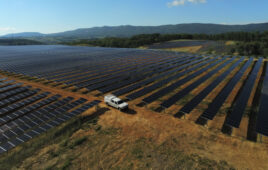U.S. Trade Representative Robert Lighthizer announced today that President Trump has approved tariffs on imported solar cells and panels, as brought on by a lengthy Section 201 trade case battle initiated by two bankrupt solar manufacturers.
Both foreign-made solar cells and modules will have a 30% tariff the first year, which will then steadily decline to 15% within four years. The first 2.5 GW of imported cells will be exempt from tariffs.
“The ITC found that U.S. producers had been seriously injured by imports and made several recommendations to the President,” Lighthizer said. “The President’s action makes clear again that the Trump Administration will always defend American workers, farmers, ranchers, and businesses in this regard.”
Industry trade organization SEIA estimates that a tariff at this level will eliminate, not add to, American manufacturing jobs. There were 38,000 jobs in solar manufacturing in the United States at the end of 2016, and all but 2,000 made something other than cells and panels, the subject of this case. Those 36,000 Americans manufactured metal racking systems, inverters, trackers and other electrical products.
SEIA estimates the tariffs will cause the loss of roughly 23,000 American jobs this year, including many in manufacturing, and will result in the delay or cancellation of billions of dollars in solar investments.
“While tariffs in this case will not create adequate cell or module manufacturing to meet U.S. demand, or keep foreign-owned Suniva and SolarWorld afloat, they will create a crisis in a part of our economy that has been thriving, which will ultimately cost tens of thousands of hard-working, blue-collar Americans their jobs,” said Abigail Ross Hopper, SEIA’s President and CEO.
Thin-film solar panels (like those manufactured by First Solar and Solar Frontier) were not expected to be affected by the tariffs, but were not officially confirmed by Lighthizer. No specific word yet as to whether crystalline silicon panels made in certain countries will be excluded from the tariffs.
The United States has long battled with solar imports from China. In 2012, duties on Chinese manufacturers were imposed after it was concluded that the Asian country was flooding the U.S. market with cheap cells and panels. When Chinese companies tried to bypass the duties by setting up manufacturing locations in Taiwan, the United States imposed additional duties on the island country in 2014. The European Union, Australia, Canada and many other countries have since initiated their own anti-dumping policies against China.
In October, the four-member ITC recommended low tariffs on imported crystalline silicon solar cells and panels–the highest being a 35% tariff on both cells and panels. The original recommendation was significantly lower than what was initially requested by U.S. panel manufacturers Suniva and SolarWorld. The two companies filed a Section 201 petition in early 2017, asking the President of the United States to grant temporary import relief by raising tariffs on goods entering the United States that injure domestic production.
The last time a Section 201 case was heard was in March 2002 when President George W. Bush decided to impose tariffs on imported steel products. Later studies estimated 200,000 Americans lost their jobs as a result of higher steel prices.
Michael Maulick, CEO of mounting manufacturer SunLink, was disappointed with the tariff announcement.
“Artificial price hikes through tariffs only work to impede economic progress when the solar industry has worked for years to make solar affordable through innovation, a global supply chain, production scale growth and private investments,” he said. “While we have always been module agnostic and supported modules of all types, we also believe the power of choice ultimately provides the most flexibility for customers to make utility-scale and commercial solar more pervasive. We remain committed to working closely with the energy industry and our manufacturing peers towards a solution that supports domestic manufacturing and domestic innovation with a global mindset to keep America solar strong.”
Many U.S. solar installation companies have been vocally against tariffs, including Maryland-headquartered Standard Solar.
“While I would have preferred to see the Trump Administration not impose any sanctions on foreign module manufacturers, which would have preserved the solar industry in its current form, the tariffs he decided to impose may slow, but will not stop the U.S. solar industry,” said Tony Clifford, CDO of Standard Solar. “The solar industry has come through worse policy decisions and will come through this one, too. The solar industry is nothing if not resilient, and I’m confident the innovative, tough and resourceful members of the industry will find workarounds to the latest obstacle placed in solar’s path. The Solar Century is here, and not even unfair tariffs will stand in its way.”
Trying to find the positive spin, SEIA’s Hopper also said the U.S. solar industry will survive.
“While we believe the decision will be significantly harmful to our industry and the economy, we appreciate that the president and the administration listened to our arguments,” Hopper said. “Our industry will emerge from this. The case for solar energy is just too strong to be held down for long, but the severe near-term impacts of these tariffs are unfortunate and avoidable.”
For those wondering where certain solar panels are manufactured, please view our manufacturing locations chart here.
Story will be updated with additional industry comments as they become available…




It is a step back for the PV industry
Is this going to bring all the coal jobs back to America?
If we already had a tariff, and we’re adding another tariff, then all the tax credit does is tell the public that we are subsidizing renewables when in fact the opposite is occurring.